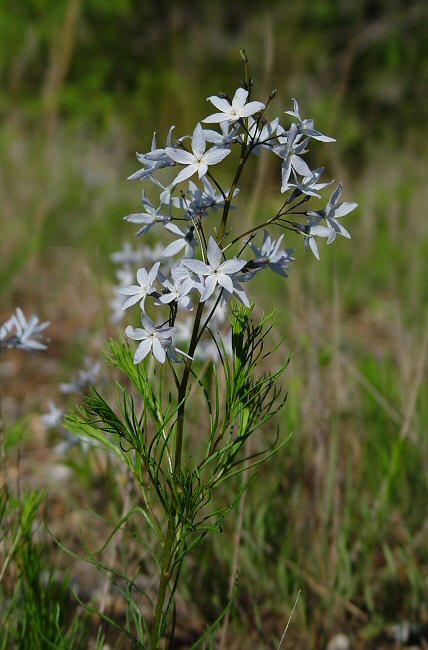Amsonia ciliata Walter
Ciliate Blue Star

Native
CC = 10
CW = 5
MOC = 4
© DETenaglia
Amsonia ciliata WalterCiliate Blue Star | |
 |
Native CC = 10 CW = 5 MOC = 4 |
© DETenaglia |
|
Family - Apocynaceae Habit - Perennial forb, sometimes with woody base. Stems - Ascending, to 50 cm, sometimes branched, glabrous or sparsely hairy.
Leaves - Alternate, often appearing nearly whorled at some nodes, sessile. Leaf blades mostly 1.5-5.0 cm long, those of the main stem leaves linear, the lowermost sometimes narrowly oblanceolate, glabrous, the margins sometimes revolute, the upper surface somewhat shiny, the undersurface pale green and often somewhat glaucous.
Inflorescences - Loose terminal clusters, 4-6 cm long at flowering, positioned above the leaves. Flower stalks 8-10 mm long, often tinged with blue.
Flowers - Calyces glabrous, the lobes 1.0-1.2 mm long, triangular. Corollas densely hairy internally, glabrous externally, the tube 6-7 mm long, about 1 mm wide at base, the throat 2.0-2.4 mm wide, the lobes 5-8 mm long, 1.5-2.5 mm wide.
Fruits - Fruits 7-13 cm long, more or less erect and held above the leaves, not constricted between the seeds, often dehiscing by a slit toward the tip. Seeds 4-7 mm long, 1.2-1.6 mm wide, the surface with wrinkled and pitted or with low, corky ridges, dark brown.
Flowering - April - May. Habitat - Limestone glades, bald knobs, edges of limestone bluffs along streams. Origin - Native to the U.S. Lookalikes - None when flowering. Other info. - This species can be found in just four southern Missouri counties. It is somewhat more common southward, ranging down into Texas, and is also present in several southeastern states. The plant can be identified by its crowded, very thin leaves, and its big inflorescences of bluish flowers. The species is somewhat variable in leaf width and corolla size and has been subdivided on that basis. Missouri plants are assignable to var. filifolia, which has very narrow leaves with revolute margins. The leaves are rugose. The plants are attractive and deserving of wider cultivation. Photographs taken at Bibb County Glades, AL., 5-1-05 (DETenaglia); also at Shaw Nature Reserve, Franklin County, MO, 4-22-2012, and near Tecumseh, Ozark County, MO, 7-2-2020 (SRTurner). |